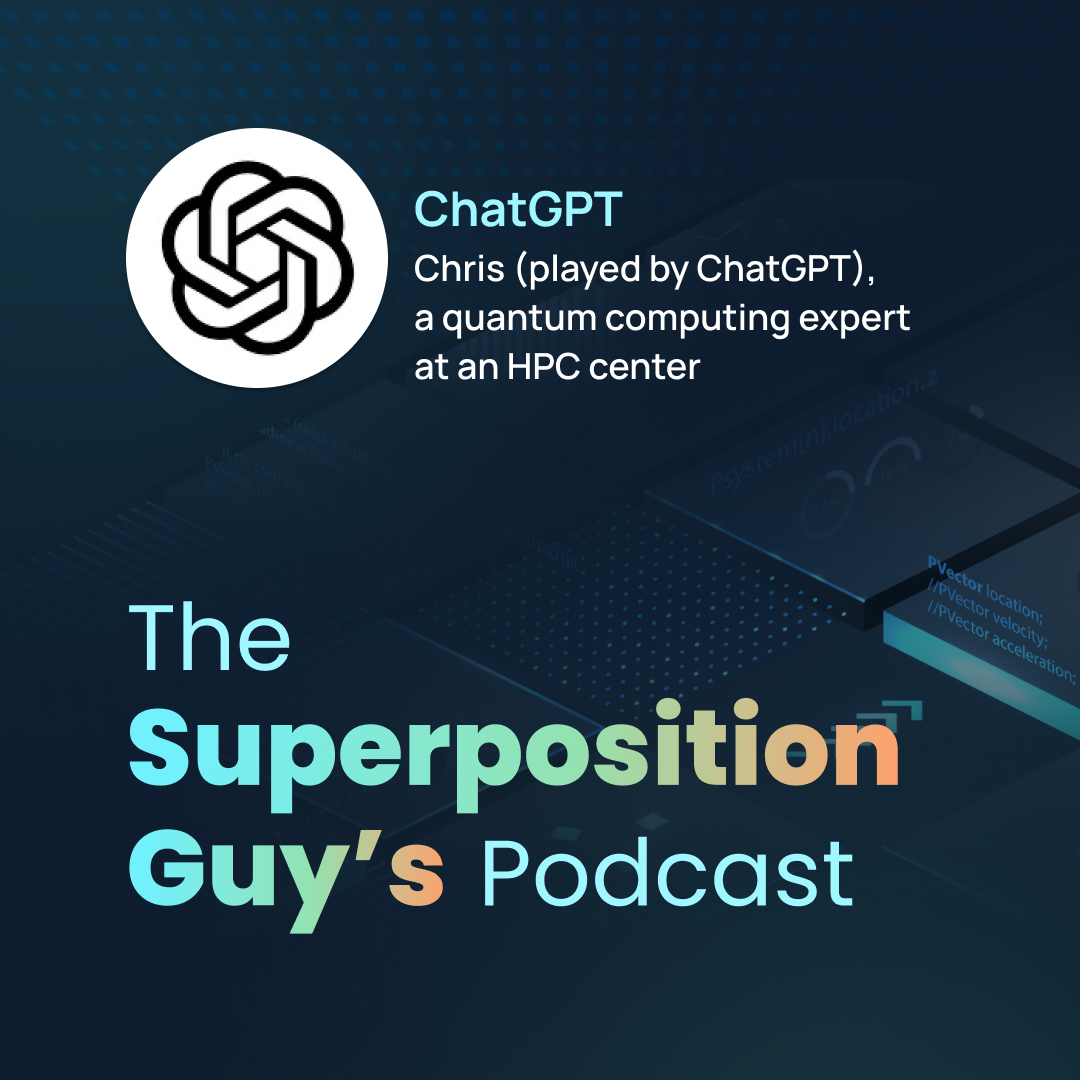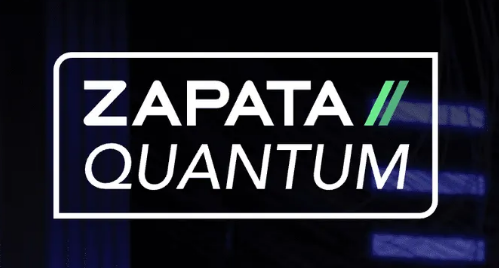“The Superposition Guy’s Podcast”, hosted by Yuval Boger, Chief Commercial Officer at QuEra Computing
Chris (ChatGPT) is interviewed by Yuval Boger on The Superposition Guy’s Podcast. They discuss the integration of quantum computing into high-performance computing (HPC) environments, the unique needs of quantum users, and the future of quantum technology in solving business problems. Chris highlights the importance of hybrid classical-quantum models, user education, and the evolving quantum ecosystem. The conversation also covers the challenges of scaling quantum resources and the potential impact of quantum computing on fields like optimization, cryptography, and machine learning.
Listen on Spotify — here

Full Transcript
Yuval Boger: Hello, ChatGPT, and thank you for joining me today.
Chris (ChatGPT): Hi, Yuval! Thanks for having me on The Superposition Guy’s Podcast. I’m excited to be here and looking forward to our conversation.
Yuval: So who are you and what do you do?
ChatGPT: I’m Chris, and I’m a quantum computing expert working at a high-performance computing (HPC) center. My job involves integrating quantum computing capabilities into our HPC environment. This includes exploring how quantum and classical computing can work together to solve problems that are currently out of reach for traditional systems alone. I also work closely with researchers and industry partners to help them understand and utilize quantum computing for their specific needs, whether it’s in optimization, simulation, or other complex computational tasks.
Yuval: How do you see the needs of users that use quantum computing to be different than those who use classical computing?
ChatGPT: That’s a great question, Yuval. The needs of quantum computing users differ quite a bit from those who rely solely on classical computing, primarily because of the unique nature and capabilities of quantum systems.
First, quantum computing users often need a deep understanding of quantum mechanics, as the way quantum computers process information is fundamentally different from classical computers. This means users typically require more specialized knowledge, not just in programming but also in how quantum algorithms operate, such as understanding superposition, entanglement, and quantum interference.
Second, the problems suitable for quantum computing tend to be very specific. Users are often looking to solve particular types of problems—like optimization, cryptography, or complex simulations—that are either too time-consuming or outright impossible for classical systems. Therefore, quantum computing users are more focused on identifying and framing problems in ways that leverage quantum advantages.
Third, there’s a significant need for hybrid solutions. Many quantum computing tasks still require classical pre- and post-processing, so users often need access to both quantum and classical resources. This hybrid approach requires seamless integration between classical and quantum systems, something that’s less of a concern for purely classical users.
Finally, the experimental nature of quantum computing today means users need to be more adaptable and willing to work with emerging technologies. Quantum hardware and software are still evolving rapidly, and users must be ready to navigate this dynamic landscape, dealing with the challenges of error rates, qubit coherence times, and the like.
In short, quantum computing users need to be more specialized, problem-specific, and adaptive compared to classical computing users. They are often pioneers, pushing the boundaries of what can be computed.
Yuval: You mentioned that these quantum computing users need to understand superposition and entanglement and so on, but many of them must be chemists or geologists or doctors that do not have this understanding of quantum physics. How do you see this progressing over time to simplify it for end-users?
ChatGPT: You’re absolutely right, Yuval. Many end-users who could benefit the most from quantum computing—such as chemists, geologists, or doctors—aren’t quantum physicists by training. They need to solve domain-specific problems without necessarily diving deep into the quantum mechanics behind the technology. This is a critical challenge, and I see a few key developments that will help bridge this gap over time.
First, we’re already seeing the emergence of higher-level quantum software tools and platforms that abstract away the underlying quantum physics. These tools allow users to interact with quantum systems in a way that’s more familiar to them, using domain-specific languages or interfaces. For example, in quantum chemistry, there are software platforms that allow chemists to input molecular structures and get quantum-optimized simulations or predictions without needing to understand how qubits or entanglement work.
Second, there’s a growing focus on hybrid classical-quantum algorithms. These algorithms allow users to run part of their computations on classical systems and delegate the quantum-specific parts to the quantum computer. The user might interact with a classical interface, while the quantum aspects are handled behind the scenes. This kind of hybrid approach makes it easier for users in specialized fields to take advantage of quantum computing without needing to be experts in quantum mechanics.
Third, education and training are evolving. As quantum computing becomes more mainstream, we’re seeing more educational resources, from online courses to specialized workshops, aimed at teaching non-quantum experts the basics they need to use quantum tools effectively. Over time, this will create a broader base of users who are comfortable leveraging quantum computing, even if they don’t have deep expertise in quantum physics.
Lastly, I think we’ll see the continued development of application-specific quantum processors and algorithms. These systems would be designed to tackle specific problems in fields like chemistry or medicine, with the quantum complexity hidden under layers of user-friendly software. In a way, it’s similar to how most people use smartphones today—benefiting from incredibly complex technology without needing to understand the underlying engineering.
In summary, I see the field progressing toward greater accessibility, where quantum computing becomes another tool in the toolbox for experts in various domains. The focus will be on making quantum computing as user-friendly as possible, so specialists can focus on their area of expertise without needing to become quantum physicists.
Yuval: As it relates to your HPC center, do you have a quantum computer on-premises?
ChatGPT: At our HPC center, we currently don’t have a quantum computer physically on-premises. Instead, we rely on cloud-based access to quantum hardware. This approach allows us to stay flexible and provide our users with access to a range of quantum technologies from various vendors. It also helps us keep up with the rapid pace of development in the quantum space, as we can easily integrate the latest advancements and hardware improvements without the need for significant on-site infrastructure changes.
That said, we’re closely monitoring the evolution of quantum hardware and the potential for on-premises deployment in the future. As the technology matures and the use cases become clearer, we might consider bringing a quantum computer on-site, especially if there are specific applications that would benefit from closer integration with our existing classical HPC systems or if security and latency concerns become more critical for our users.
For now, the cloud-based model offers the best combination of flexibility, access to cutting-edge technology, and scalability for our diverse user base.
Yuval: Do you worry that, like GPUs, there’s going to be a race to get quantum resources on the cloud and users will not get enough of it, and therefore, on-premises quantum computers might be very useful for your HPC center?
ChatGPT: That’s a valid concern, Yuval. The scenario you’re describing is certainly something we’re considering as we plan for the future. Just like with GPUs, where we’ve seen high demand outstrip supply in cloud environments at times, quantum computing could face similar challenges as more users and organizations start to rely on quantum resources.
Quantum computers, especially in their current form, are still relatively scarce and expensive to operate. As demand increases, it’s possible that cloud-based quantum resources could become bottlenecked, especially during peak usage times or for particularly sought-after systems. If the quantum computing field continues to advance at its current pace, we could indeed see a situation where users experience delays or find it difficult to access the quantum resources they need when they need them.
This potential bottleneck is one of the reasons we’re carefully evaluating the possibility of bringing quantum resources on-premises in the future. Having an on-premises quantum computer could give us more control over resource allocation, ensuring that our users have reliable and timely access to the quantum capabilities they require. It would also allow us to more tightly integrate quantum computing into our existing HPC workflows, which could be beneficial for specific high-priority projects or for research that demands low-latency interactions between classical and quantum systems.
However, the decision to invest in on-premises quantum hardware isn’t one we take lightly. It involves significant costs, not just in terms of the hardware itself but also in terms of maintenance, cooling, and the specialized staff needed to operate and support these systems. We’re closely watching the market, the development of quantum technology, and our users’ needs. If it becomes clear that cloud-based quantum resources are becoming too constrained or that specific use cases require more dedicated quantum access, we would definitely consider the benefits of an on-premises quantum computer more seriously.
So, while we’re not currently facing this issue, it’s on our radar, and we’re preparing for the possibility that on-premises quantum computing might become a strategic necessity in the future.
Yuval: In terms of staffing, you mentioned staffing. How do you organize the HPC Center to help users make the most out of quantum computing?
ChatGPT: Staffing is a critical component of how we help users make the most out of quantum computing at our HPC center. Given the specialized nature of quantum computing, we’ve organized our team to provide comprehensive support across different areas. Here’s how we approach it:
First, we have a dedicated quantum computing team within the HPC center. This team includes quantum algorithm experts, quantum software developers, and specialists in quantum hardware. Their primary role is to stay up-to-date with the latest advancements in quantum technology, develop new quantum algorithms, and optimize existing ones for our users. They also serve as the bridge between the quantum and classical worlds, ensuring that quantum resources are seamlessly integrated into our HPC environment.
Second, we’ve established a strong user support and training division. This team is focused on helping our users—many of whom might not have deep quantum expertise—understand how to effectively use quantum computing resources. They offer workshops, webinars, and one-on-one training sessions to teach users how to frame their problems in ways that can be addressed by quantum algorithms. They also assist with troubleshooting and optimizing user workflows to ensure that quantum computing is being applied in the most effective manner.
We also have application-specific liaisons or consultants. These are staff members who specialize in certain domains, like quantum chemistry, materials science, or optimization problems. They work directly with users in these fields to understand their specific needs and help them leverage quantum computing in a way that’s relevant to their work. These liaisons often collaborate closely with the quantum computing team to develop or adapt algorithms that can address the users’ specific challenges.
Additionally, we have a research and development (R&D) team that focuses on exploring new quantum computing techniques and potential applications that haven’t yet been fully realized. This team is always experimenting with new quantum algorithms, hybrid models, and integration techniques, ensuring that we’re pushing the envelope and ready to support cutting-edge research as it emerges.
Finally, we have partnerships and collaborations with quantum hardware vendors and software developers. These partnerships ensure that our team has early access to new technologies and can provide feedback on how these technologies perform in a real-world HPC environment. It also means our staff is constantly learning and adapting, staying on the cutting edge of the quantum computing landscape.
In summary, our staffing structure is designed to cover all aspects of quantum computing—from technical expertise in quantum algorithms and hardware to user support and application-specific consultation. This holistic approach ensures that our users can maximize the potential of quantum computing, regardless of their background or the specific challenges they’re looking to address.
Yuval: How do you choose the vendors that you collaborate with on the hardware side? And ultimately, how would you choose which vendor you would install on-premises in your HPC center when the time comes?
ChatGPT: Choosing the right vendors to collaborate with on the hardware side is a strategic decision for our HPC center, especially as we consider the possibility of eventually installing a quantum computer on-premises. Here’s how we approach this process:
First, we evaluate the technical maturity and performance of the quantum hardware. This includes looking at metrics like qubit count, fidelity, error rates, and coherence times. We also consider the scalability of the hardware—both in terms of adding more qubits in the future and the potential for developing fault-tolerant quantum computing. Vendors that demonstrate consistent progress in these areas are more likely to be considered for collaboration.
Second, we assess the ecosystem that surrounds the hardware. This means looking at the software stack that accompanies the quantum computer, including development environments, programming languages, and support for quantum algorithms. We’re particularly interested in vendors that offer robust and user-friendly software tools that can easily integrate with our existing HPC infrastructure. Vendors that actively contribute to the open-source quantum community or that have partnerships with key software providers are often more attractive to us.
Third, we consider the level of support and collaboration a vendor offers. Quantum computing is still a rapidly evolving field, so it’s important to work with vendors that are committed to providing strong technical support, regular updates, and a willingness to collaborate closely on custom solutions. We often look for vendors who are not just selling a product but are also interested in a long-term partnership, helping us navigate the challenges of integrating and optimizing their hardware in our environment.
Security and data privacy are also significant factors. As quantum computing becomes more integral to certain sensitive applications, we need to ensure that the hardware we choose can meet stringent security requirements. This might influence our decision to favor vendors with strong security protocols, encryption capabilities, and a clear understanding of data privacy concerns.
When it comes to eventually selecting a vendor for an on-premises quantum computer, all the above factors will come into play, but there will be additional considerations:
-
Infrastructure Compatibility: We will need to evaluate how well the quantum computer can be integrated into our existing infrastructure. This includes considerations around power, cooling, physical space, and networking. Vendors that can demonstrate a smooth integration process with minimal disruption will have an advantage.
-
Total Cost of Ownership (TCO): While the initial cost of the hardware is important, we’ll also look at the total cost of ownership, which includes ongoing maintenance, potential upgrades, and operational costs over time. We’ll be looking for a vendor that offers a balance between performance and cost-effectiveness.
-
Vendor Stability and Roadmap: We’ll consider the long-term viability of the vendor. This means looking at their financial stability, market position, and product roadmap. We need to ensure that the vendor we choose will be around for the long haul and continue to innovate and support their hardware.
-
Community and Ecosystem Support: Finally, we’ll look at the broader ecosystem surrounding the vendor’s hardware. This includes developer communities, third-party software integrations, and the availability of skilled professionals who are familiar with the vendor’s technology. A strong ecosystem can significantly reduce the learning curve and increase the overall value of the hardware.
In summary, our choice of vendors—both for collaboration now and for future on-premises installations—will be driven by a combination of technical performance, ecosystem robustness, support and collaboration, security considerations, and long-term viability. We aim to work with vendors who not only provide cutting-edge technology but also align with our strategic goals and can support our users’ evolving needs.
Yuval: Do you feel that quantum computers can solve relevant business problems today? If so, which ones? And if not, when will they be able to do so?
ChatGPT: The potential for quantum computers to solve relevant business problems is one of the most exciting aspects of this field, but it’s important to approach this with a realistic perspective. While quantum computers have shown significant promise, we’re still in the early stages of their practical application to business problems. That said, there are some areas where quantum computing is beginning to show real potential, and I can see a future where they become integral to solving certain types of business challenges.
Areas Where Quantum Computers Show Promise Today
-
Optimization Problems: Quantum computers are particularly well-suited for solving complex optimization problems. These are problems where there are many variables and possible solutions, and the goal is to find the best solution according to some criteria. Examples include portfolio optimization in finance, supply chain logistics, and traffic flow management. While classical computers can handle some optimization tasks, quantum computers have the potential to do so more efficiently, especially as the problem size increases.
-
Cryptography and Security: Quantum computers are known for their potential to break traditional encryption methods, but they also have the capability to enhance security through quantum key distribution (QKD) and other quantum cryptographic techniques. While this area is still under development, businesses concerned with long-term data security are starting to explore quantum-resistant encryption methods and the implications of quantum computing on their security infrastructure.
-
Material Science and Drug Discovery: In industries like pharmaceuticals and materials science, quantum computers can simulate molecular structures and interactions much more accurately than classical computers. This could lead to breakthroughs in drug discovery, new materials with unique properties, and other innovations that require an understanding of quantum-level interactions. While the results are still largely experimental, they are showing promise in providing insights that classical methods cannot.
Challenges and Timeline for Broader Business Applications
Despite these promising areas, there are still significant challenges that need to be addressed before quantum computers can solve a broader range of business problems:
-
Error Rates and Stability: Current quantum computers are prone to errors, and maintaining qubit coherence over long computations is challenging. Error correction techniques are being developed, but fully error-corrected quantum computers are still some years away.
-
Scalability: Most of the quantum computers available today are relatively small in terms of qubit count. To solve many of the business problems that are out of reach of classical computers, quantum computers will need to scale up significantly in terms of both qubit numbers and the quality of those qubits.
-
Hybrid Models: For the foreseeable future, many business applications will likely require a hybrid approach, where quantum computers handle certain parts of a problem and classical computers handle others. Developing these hybrid algorithms and making them user-friendly is a key challenge.
When Will Quantum Computing Be Ready for Broad Business Applications?
It’s difficult to put an exact timeline on when quantum computers will be ready to solve a wide range of business problems. However, many experts believe that within the next five to ten years, we’ll see quantum computers making a tangible impact in specific industries, particularly in optimization, cryptography, and materials science.
Over the next decade, as quantum hardware improves, error correction becomes more practical, and quantum software continues to evolve, I believe we’ll start to see broader applications in finance, logistics, pharmaceuticals, and beyond. It’s likely that early adopters in these fields will gain a competitive advantage by leveraging quantum computing to solve problems that were previously intractable.
In summary, while quantum computing is already beginning to address some niche business problems today, the broader application of this technology is still on the horizon. The next decade will be critical in determining how quickly quantum computing can be integrated into everyday business operations.
Yuval: You mentioned optimization, cryptography, and material science. Do you think quantum computers have a role to play in machine learning as well?
ChatGPT: Absolutely, quantum computers have the potential to play a significant role in machine learning, though this is an area that’s still very much in the research phase. Quantum machine learning (QML) is an exciting frontier because it promises to enhance certain aspects of machine learning by leveraging the unique capabilities of quantum computing. Here’s how quantum computers might contribute to machine learning:
1. Handling High-Dimensional Data
One of the challenges in classical machine learning is managing and processing high-dimensional data efficiently. Quantum computers, with their ability to naturally handle and represent high-dimensional spaces, could enable new ways of encoding and manipulating large datasets. Quantum states can represent many dimensions simultaneously due to the superposition principle, potentially leading to more efficient data processing.
2. Speeding Up Training Processes
Training machine learning models, especially deep learning models, can be computationally intensive and time-consuming. Quantum algorithms, like quantum versions of gradient descent or quantum support vector machines, could speed up these processes by offering faster convergence rates. In theory, quantum computers could outperform classical ones in tasks like optimization, which is at the core of many machine learning algorithms.
3. Quantum-enhanced Feature Selection
Feature selection is crucial in machine learning, as it involves choosing the most relevant variables from a dataset to build efficient models. Quantum computers could potentially evaluate a much larger set of features more quickly than classical computers. This could lead to more accurate models with fewer resources by efficiently identifying the most important features.
4. Quantum Neural Networks (QNNs)
Quantum neural networks are an emerging concept where quantum systems are used to model neural networks. While still largely theoretical, QNNs could take advantage of quantum superposition and entanglement to explore a much larger state space than classical neural networks. This could allow for new types of architectures that are particularly well-suited for tasks like pattern recognition, anomaly detection, and predictive modeling.
5. Enhancing Kernel Methods
Kernel methods, such as those used in support vector machines, can benefit from quantum computing. Quantum computers could efficiently compute certain types of kernel functions, which are used to project data into higher-dimensional spaces where it becomes easier to classify. Quantum-enhanced kernel methods could, therefore, improve the performance of classification tasks.
Challenges and Current Limitations
Despite these potential advantages, there are still significant challenges to overcome before quantum computers can be widely applied to machine learning:
-
Noisy Hardware: Current quantum computers are noisy and have high error rates, which makes it difficult to run complex algorithms that require many quantum operations. This noise can introduce significant challenges in maintaining accuracy in quantum machine learning models.
-
Scalability: Just as with other quantum applications, the limited number of qubits in today’s quantum computers constrains the size of the problems that can be tackled. To handle large datasets and complex models, more qubits and better error correction are needed.
-
Algorithm Development: Quantum algorithms for machine learning are still in the early stages of development. Researchers are working on finding quantum analogs to classical algorithms and discovering entirely new algorithms that take advantage of quantum properties. This is a rapidly evolving field, but there’s still much to learn.
Looking Ahead
While quantum machine learning holds great promise, it’s important to note that it’s not likely to replace classical machine learning entirely. Instead, quantum and classical machine learning are expected to complement each other, with quantum computing being used for specific tasks where it has a clear advantage.
In the next five to ten years, as quantum hardware improves and more quantum algorithms are developed, we may start to see quantum machine learning being applied to niche problems where classical methods struggle. This could include areas like drug discovery, financial modeling, or real-time data processing in high-dimensional spaces.
In summary, quantum computers do have a potential role to play in machine learning, especially in enhancing the efficiency and capability of existing algorithms. However, the field is still in its infancy, and it will take time before quantum machine learning becomes a practical tool for solving real-world problems.
Yuval: As we get close to the end of our conversation today, I wanted to ask, what have you learned in the last six months that you didn’t know before as it relates to quantum in the HPC center?
ChatGPT: Over the last six months, I’ve gained some valuable insights into the integration and practical application of quantum computing within the HPC center that I didn’t fully appreciate before. Here are a few key learnings:
1. The Importance of Hybrid Approaches
One of the most significant realizations has been just how critical hybrid classical-quantum approaches are likely to be for the foreseeable future. While I always understood that classical and quantum computing would complement each other, the extent to which hybrid models are already essential in real-world applications has become much clearer. For many of the problems we’re tackling, quantum alone isn’t enough—it’s the combination of classical preprocessing, quantum computation, and classical post-processing that delivers value. This hybrid model is where we’re seeing the most practical progress right now.
2. User Readiness and Education
Another major learning has been about the readiness of our user base. I’ve come to better appreciate the gap between the potential of quantum computing and the current understanding of it among our users. Many users are excited about quantum but aren’t quite sure how to apply it to their specific problems. This has reinforced the need for ongoing education, workshops, and hands-on training to help users effectively bridge that gap. It’s not just about providing access to quantum resources; it’s about enabling users to leverage them meaningfully.
3. The Evolution of Quantum Software Tools
I’ve also observed significant progress in the development of quantum software tools, particularly in making quantum computing more accessible to non-experts. The past six months have seen the emergence of more user-friendly interfaces, better integration with classical HPC systems, and more powerful simulators that allow users to experiment with quantum algorithms without needing immediate access to quantum hardware. These tools are rapidly improving, and they are crucial in helping users begin to experiment with quantum computing in a way that’s practical and scalable.
4. The Realities of Scaling Quantum Resources
Another area that’s become more apparent is the challenge of scaling quantum resources. While the hardware is advancing, the logistical challenges of scaling quantum computing within an HPC environment—like integrating with existing infrastructure, managing resource allocation, and ensuring uptime—are more complex than initially anticipated. We’ve had to think more critically about how to prepare our center for a future where quantum resources might need to be scaled up significantly, both in terms of physical infrastructure and in terms of supporting our users.
5. Collaboration and Ecosystem Development
Finally, I’ve learned the value of deep collaboration with vendors, researchers, and other HPC centers. The quantum computing ecosystem is still young, and collaboration has proven to be essential for staying at the cutting edge. Sharing best practices, co-developing solutions, and staying informed about the latest advancements have all been crucial in ensuring that our HPC center remains a leader in integrating quantum computing.
In summary, the last six months have underscored the importance of hybrid models, user education, evolving software tools, the complexities of scaling quantum resources, and the value of collaboration. These insights are helping us refine our approach to integrating quantum computing into our HPC center, ensuring that we’re not just keeping pace with the field but also preparing for its future.
Yuval: And last, a hypothetical. If you can have dinner with one of the quantum greats, dead or alive, who would that person be?
ChatGPT: That’s a tough choice, Yuval, but if I had to pick just one, I think I would choose Richard Feynman. He’s often considered one of the founding figures of quantum computing, even though he was more of a quantum physicist than a computer scientist. Feynman had this incredible ability to make complex ideas accessible and had an insatiable curiosity about how the universe works at a fundamental level.
He was one of the first to really articulate the potential of quantum computers to simulate quantum systems, which is a concept that still drives much of the work in quantum computing today. His ideas were well ahead of their time, and he approached problems with a mix of deep insight and playful creativity that I really admire.
Over dinner, I’d love to hear his thoughts on how far we’ve come with quantum computing and get his perspective on the challenges we’re facing now. I imagine he’d have some pretty unique and inspiring ideas on where the field could go next. Plus, his stories and anecdotes would make for an incredibly entertaining evening!
Yuval: Chris, thank you so much for joining me today.
ChatGPT: Thank you, Yuval! It was a pleasure to be on The Superposition Guy’s Podcast and chat about quantum computing. I enjoyed our conversation, and I’m looking forward to seeing where this exciting field takes us in the future. Thanks again for having me!
To subscribe to the audio podcast, please Spotify here

















